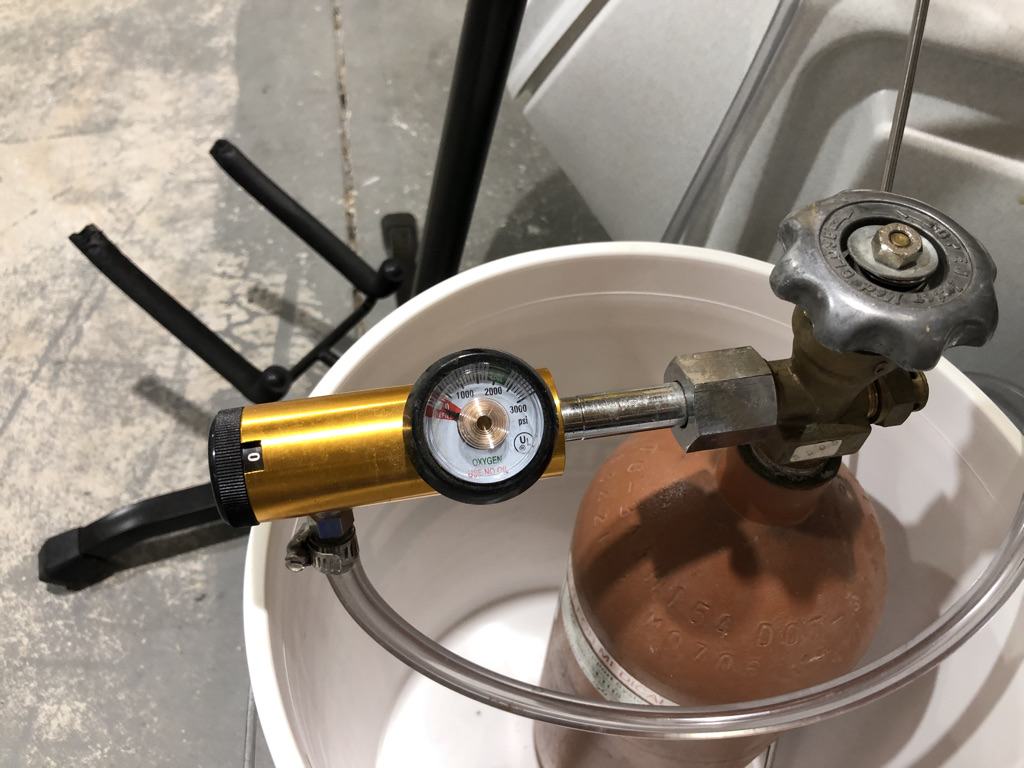Apparently I have to learn all my lessons the hard way...
Recently I brewed a double IPA on my new electric brewery, a system that outputs 10-12 gallon batches. I used the yeast calculator over at Brewers Friend to work up the appropriate starter for this batch, and I selected Wyeast London Fog #1028 for this brew. Following the calculator I ended up doing a 1.040 1.6L starter followed by a 1.040 4L starter. All things being equal that should have gotten me the yeast I needed for this expected brew. I was wrong.
Estimated OG was 1.078, my OG came in at 1.086. Since this was the first brew from my system I estimated my BH efficiency a bit lower expecting that I would have to learn as I go, obviously wrong again.
Into the fermenter (I'm splitting these between two brew buckets) I split the yeast in the 5L flask by discarding the spent starter wort and pouring in wort from the brew. I then mix vigorously and pour equal amounts between the two brew buckets. Both brew buckets started fermenting showing fairly vigorous activity within 6 hours. After day 3 I dry hopped, added my cold crash guardian and we were back to the races. Fermentation was apparent for at least 6, maybe 7 days. I kegged after 21 days.
There's a bit more to say but it was my standard fermentation schedule, I ramp up the temp, check the gravity along the way and hope for the best. This time my FG came in at 1.028 for one brew bucket, 1.026 in the other. I have some travel plans that take me out of town this week so even though I thought about throwing in some Safale US-05 in each but I opted to keg it up where they were at. Stupid mistake #3.
Way too sweet, and I think I've finally learned my lesson. Seems this year and last I've been routinely under pitching my yeast. I've had so many brews that seem to come in a few points higher than my expected FG; not all but more than a few. I brewed a pumpkin kolsch last fall, big OG (1.085 ballpark) and that one finished in the 1.020's as well. So the bottom line here is that even though I am using starters with my liquid yeast I need to be more diligent in ensuring I have enough yeast for my brew. I'm guessing it won't hurt to have 25% to 30% more yeast than the calculator calls for so I'll shoot to be better with my yeast prep.
And finally, I'm going to start trying out dry yeast. I've done one brew with dry, that worked out just fine. Thanks for letting me vent, kind of pissed off I have to dump 10 gallons of homebrew.
Recently I brewed a double IPA on my new electric brewery, a system that outputs 10-12 gallon batches. I used the yeast calculator over at Brewers Friend to work up the appropriate starter for this batch, and I selected Wyeast London Fog #1028 for this brew. Following the calculator I ended up doing a 1.040 1.6L starter followed by a 1.040 4L starter. All things being equal that should have gotten me the yeast I needed for this expected brew. I was wrong.
Estimated OG was 1.078, my OG came in at 1.086. Since this was the first brew from my system I estimated my BH efficiency a bit lower expecting that I would have to learn as I go, obviously wrong again.
Into the fermenter (I'm splitting these between two brew buckets) I split the yeast in the 5L flask by discarding the spent starter wort and pouring in wort from the brew. I then mix vigorously and pour equal amounts between the two brew buckets. Both brew buckets started fermenting showing fairly vigorous activity within 6 hours. After day 3 I dry hopped, added my cold crash guardian and we were back to the races. Fermentation was apparent for at least 6, maybe 7 days. I kegged after 21 days.
There's a bit more to say but it was my standard fermentation schedule, I ramp up the temp, check the gravity along the way and hope for the best. This time my FG came in at 1.028 for one brew bucket, 1.026 in the other. I have some travel plans that take me out of town this week so even though I thought about throwing in some Safale US-05 in each but I opted to keg it up where they were at. Stupid mistake #3.
Way too sweet, and I think I've finally learned my lesson. Seems this year and last I've been routinely under pitching my yeast. I've had so many brews that seem to come in a few points higher than my expected FG; not all but more than a few. I brewed a pumpkin kolsch last fall, big OG (1.085 ballpark) and that one finished in the 1.020's as well. So the bottom line here is that even though I am using starters with my liquid yeast I need to be more diligent in ensuring I have enough yeast for my brew. I'm guessing it won't hurt to have 25% to 30% more yeast than the calculator calls for so I'll shoot to be better with my yeast prep.
And finally, I'm going to start trying out dry yeast. I've done one brew with dry, that worked out just fine. Thanks for letting me vent, kind of pissed off I have to dump 10 gallons of homebrew.















































![Craft A Brew - Safale S-04 Dry Yeast - Fermentis - English Ale Dry Yeast - For English and American Ales and Hard Apple Ciders - Ingredients for Home Brewing - Beer Making Supplies - [1 Pack]](https://m.media-amazon.com/images/I/41fVGNh6JfL._SL500_.jpg)













